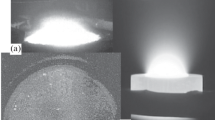Conclusions
-
1.
The rate of evaporation at a cathode with the spot fixed in its cylinder is 0.2 mg/a under stable, and 0.16 mg/a under unstable conditions.
-
2.
The pressure on the cathode of 23 dyne/a under stable conditions and of 19.17 dyne/a under unstable arc conditions is due to the reflection of neutralized ions from the cathode, and to a lesser extent to evaporation of mercury from the cathode.
-
3.
The pressure of the neutralized ions reflected from the cathode is the fundamental condition for cutting off the current. The current value at which this takes place depends on the method of fixing the cathode spot and the arcing conditions. For the same method of locating the spot, the current is cut off at the same pressure on the cathode under both stable and unstable conditions.
-
4.
The main direction of movement of the beam of neutralized mercury ions reflected from the cathode is normal to the surface of the cathode covered by the spot. This is confirmed by the rapid increase in pressure on the vane due to the beam of mercury particles when shifting from the vertical plane of the spot to one with an inclination to the horizontal.
-
5.
When the spot is fixed on the mercury-wetted molybdenum wall of the cathode cylinder at low currents, 2.5–3 a, only a very small part of the beam of reflected, neutralized ions reaches the vane directly. The main pressure on the vane is due to a beam of mercury vapor. The temperature determined from the rate of evaporation and the pressure produced by the vapor on the vane is 471 ° K.
-
6.
The temperature of the cathode spot is 492 ° K when determined from the increase in evaporation rate, and the pressure due to it, when changing from a cooled to a heated cathode.
-
7.
Such low temperatures at a mercury cathode, 471–492 ° K can hardly affect the emission of electrons from the surface of the mercury cathode.
Similar content being viewed by others
References
R. Tanberg, Physical Review.35, 9, 1080, 1930.
E. Kobel, Physical Review,36, 1633, 1930.
K. Compton, Physical Review,36, 15, 1930.
M. E. Hankey and F. M. Johnson, Science,78, 415, 1933.
A. Yu. Nikiforov and T. M. Sviridov, Zeitschrift für Physik, 97, 5 and 6, no. 398, 1935.
I. Langmuir, Phys. Zeits.,14, 1273, 1913.
J. Roberts, Heat and Thermodynamics [Russian translation], Moscow, GITTL, 1950.
A. Ya. Nikiforov, Uchenye zapiski Kazanskogo gosuniversiteta, Trudy conferentsii molodykh uchenykh, no. 2, 1937.
Tb. Waserrab, Z. f. Phys., 130, 1951.
H. Bertele, F. I. Pb. Purley, Surrey and Wien, Acta phisica austriaca, 9, no. 2, 124, 1955.
A. W. Hull, Physical Review, 126, 5, 1603, 1962.
Author information
Authors and Affiliations
Additional information
We would like to take this opportunity to thank T. M. Sviridov for his discussion of our results and his valuable criticism.
Rights and permissions
About this article
Cite this article
Nikiforov, A.Y. The temperature at a mercury cathode at low pressure. Soviet Physics Journal 9, 67–72 (1966). https://doi.org/10.1007/BF00818744
Revised:
Issue Date:
DOI: https://doi.org/10.1007/BF00818744



